Head Harbour Passage to the Wolves Accessible Exploration
Explore the Seafloor
Come whale watching in Head Harbour Passage! Let images and videos introduce you to the whales, birds, and other species that visit here.
-
Minke Whale 'Slice'
View species
This minke whale is known locally as “Slice” due to its damaged dorsal fin. Slice is often spotted in the area. Here Slice is surfacing just off Head Harbour Lightstation.
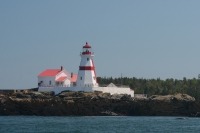
(Photo: Danielle Dion)

-
Seabirds on Race Rock
View species
These double-crested cormorants are taking a break on Race Rock between bouts of feeding. Day-time resting places, such as this rock, are known as loafing areas. Double-crested cormorants mostly feed on fish. They dive from the surface and pursue their prey underwater, using their feet for propulsion. A hook-like projection on the upper half of their bill helps them grasp their prey.
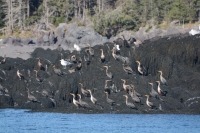
(Photo: Danielle Dion)

-
Harbour Porpoise and Calf
View species
Harbour porpoise calves are dependent on their mothers for one to two years after birth. The mother feeds the calf on milk for about nine months. From five months, the calf also eats solid food. The porpoise cannot make a seal around its mother’s nipple to suck, so instead, the mother squirts milk into its mouth.

(Photo: Danielle Dion)

-
Herring Bait Ball
Video Description: We watch from above. A dark ball is visible below the sea surface. Porpoise and minke whales have chased these herring up to the surface. Each herring now tries to save itself by moving to the centre of the shoal. This eventually forms the shoal into a ball, known as a bait ball. A feeding frenzy can develop as predators compete for prey. We see bright white seagulls soar over the water and dive down at the bait ball from above. Several porpoises dart in towards the sides of the ball, picking off straggling fish. Then a minke whale lunges up from underneath the ball, scooping herring into its vast mouth. This video has no sound.
-
Harbour Seal
View species
Harbour seals dive down to forage close to the seabed. They mainly eat small prey that can be swallowed whole. This includes fish, shrimps, and squid.
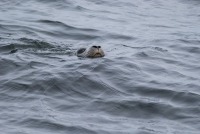
(Photo: Nick Hawkins)

-
Lunge Feeding Humpbacks
View species
Humpback whales feed on krill and small fish such as herring. During lunge feeding, the whale accelerates through dense patches of prey at high speed. It holds its mouth open at about 90 degrees, and its pleated throat expands to hold a vast volume of water. When the whale’s jaws close, its body takes on a bloated tadpole shape. The whale then contracts its throat to expel the water through hundreds of baleen plates. These act as a sieve, leaving the prey inside the whale’s mouth.

(Photo: Rika Nason)

-
Head Harbour Light at Sunrise
Head Harbour Lightstation, also known as East Quoddy Head Lightstation, is situated on a small rocky islet at the northern end of Campobello Island. It was built in 1829 and is one of the oldest standing lighthouses in Canada. It was manned until 1986.

(Photo: Farley Pat Mowatt)

-
Humpback Whale off Wilson's Beach
View species
We can identify humpback whales from the white marks on their tail flukes – these are unique to each individual. This is “Triton.” The Centre for Coastal Studies in Provincetown, MA, manages a catalogue of Gulf of Maine humpbacks. This contains information on over 3000 individual whales, including age, sex, and number of offspring. When contributors sight an individual, they can send in photos. Scientists can then use the catalogue to identify individuals and study their movements. Huntsman staff and local whale watching operator Quoddy Link Marine contribute to the catalogue. The catalogue tells us that Triton is a mature male and was first spotted in 1981, making him at least 39 years old. This photo was taken a bit further south, off Wilson’s Beach, Campobello Island.

(Photo: Danielle Dion)

-
Finback Whale
View species
Finback whales or fin whales are the second-largest in the world, after the blue whale. They come into the Bay of Fundy to feed on the abundant krill and small fish found here. They are nicknamed the “greyhound of the sea” because their streamlined shape makes them fast swimmers. They can reach speeds of up to 40 kilometres per hour.
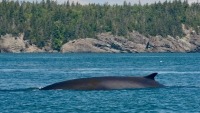
(Photo: Danielle Dion)

-
Bald Eagle
View species
Bald eagles are frequently seen in the Quoddy region and are present here year-round. This individual is perching on a navigational marker situated on Halftide Ledge, off the north-west side of Casco Bay Island.
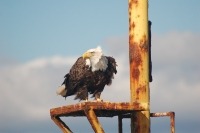
(Photo: Danielle Dion)

-
Lion's Mane Sea Jelly
View species
Lion’s mane sea jellies are frequently spotted in the Bay of Fundy during the summer months. This species is known as the giant sea jelly; the biggest individual recorded had a bell 2.3 metres in diameter and tentacles over 37 metres long – that’s longer than a blue whale! The individuals found here are usually much smaller. Although they can swim slowly by pulsating their bell, the sea jellies mainly drift with ocean currents.
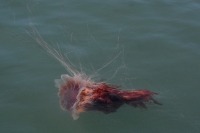
(Photo: Danielle Dion)

-
Harbour Seal with Healed Shark Bite
View species
This harbour seal was bitten by a great white shark in 2013 but survived the attack. Danielle Dion, from local whale-watching operation Quoddy Link Marine, has been monitoring its recovery.

(Photo: Danielle Dion)

-
Ocean Sunfish
View species
Video Description: We see the strange oval form of an ocean sunfish swimming at the surface of a slightly wavy sea. It flaps the small pectoral fin in the middle of its body and undulates its larger fins as it slowly swims toward us. We can hear the splashing of the waves and exclamations from the boat passengers.
Ocean sunfish are the largest bony fish, weighing up to 2300 kilograms and reaching 3.3 metres in length. Although they spend most of their time underwater, they are sometimes seen basking at the surface. Scientists think this behaviour might help warm their bodies after spending time in the cold deep ocean. They come into coastal areas of the Bay of Fundy in summer and early fall. Despite their odd appearance, ocean sunfish are powerful swimmers that can dive to depths of over 500 metres and even jump out of the water.
-
Breaching Finback Whale
View species
Video Description: We watch from the Quoddy Link whale watching vessel as a finback whale breaches out of the water. It falls back in with an incredible splash. “This is a breaching fin whale” the onboard naturalist explains, adding that it is something she’s never seen in fifteen years. We see a flock of seabirds fly across the scene. We watch for the whale to surface. Then it leaps out of the water again, twisting so it falls back with its white belly skyward, again with a colossal splash. The whale watchers exclaim in amazement.
This species is the second-largest whale, after the blue whale, and is the largest whale known to breach. It is thought that this individual was over 18 metres long and weighed over 45 000 kilograms. Breaching is very rare in finback whales, so this was a very unusual sighting.
-
Herring Gulls with Chicks
View species
Herring gulls breed on White Horse Island. The chicks can’t fly until they are around 45 days old so they stay close to the nest site. Parents take turns to stay with the chicks until they are 30 days old. Parents feed chicks until they are 11 to 12 weeks old. When parents return from foraging, chicks rush up and beg until the adult regurgitates food for them.
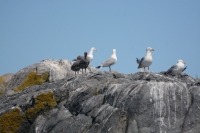
(Photo: Danielle Dion)

-
Nesting Black-Legged Kittiwakes
View species
Around 150 black-legged kittiwakes nest on White Horse Island. Kittiwakes can nest on ledges as small as 10 centimetres wide. Chicks face into the cliff or sideways to reduce the risk of falling. Chicks are brooded by a parent for six to eight days, until they can regulate their body temperature. They stay in the nest for between 30 and 60 days, and the parents feed them.
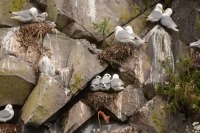
(Photo: Danielle Dion)

-
Atlantic Puffins
View species
Puffins dive down to catch the schooling fish they prey on. They can catch several fish on each dive. These are either swallowed whole or held in the bill, clamped against the roof of the puffin’s mouth. Backward-pointing spines on the puffin’s mouth and tongue help it grasp the slippery bodies. In breeding season (May to July), puffins usually forage within five kilometres of their breeding colonies. Small numbers have bred on White Horse Island, but the nearest significant colony is Machias Seal Island, which has over 3000 breeding pairs.

(Photo: Jolinne Surette)

-
Feeding Seabirds
Large numbers of seabirds congregate in the area between Bliss Island and Head Harbour Lightstation. Upwellings in this area concentrate the krill and fish the birds feed on.

(Photo: Jolinne Surette)

-
Razorbills on White Horse island
View species
Razorbills resting between foraging trips, on the southeastern shore of White Horse Island. They feed on fish and krill, which are both concentrated by the tidal upwellings in this area. To chase their prey, they dive into the water and use their wings to swim. Razorbills are not known to breed on White Horse Island, but scientists recorded two breeding pairs on nearby South Wolf Island.
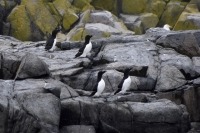
(Photo: Jolinne Surette)

-
Bonaparte’s gulls on black rock
View species
Bonaparte’s gulls are one of the smallest gulls in North America. This flock was sighted in late August when they would have been on their southward migration from their breeding grounds in north-west Canada and Alaska. This species is usually present in the Bay of Fundy from July to December but does occasionally overwinter. The gulls arrive in a succession of waves and remain in the area for several weeks to feed.
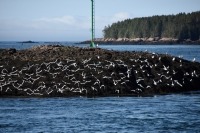
(Photo: Jolinne Surette)

The Wolves
Enjoy a boat trip with whale researchers to the Wolves Islands on the outmost fringes of the Quoddy region. Find out how they study and rescue right whales. Learn how they take a biopsy sample and do a plankton tow. See some of the oceanic species that visit this remote archipelago.
-
Right Whale Group and the ‘Nereid’
Learn more
Researchers from the New England Aquarium’s Anderson Cabot Center study right whales from the ‘Nereid’, their research vessel. These right whales are engaged in a Surface Active Group (SAG). Scientists define a SAG as two or more whales, within a body length of each, other, interacting at the surface. Typically a SAG is comprised of one female and several males competing with each other to mate with her. Some SAGs are extremely active, with a lot of rolling and white water, whereas others are more sedate. The number of animals in a SAG can range from two or three to more than 40.
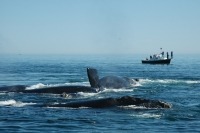
(Photo: Anderson Cabot Center/New England Aquarium)

-
Right Whale biopsy (Image 1 of 3)
Learn more
Yan Guilbault stands poised on the bow of the Anderson Cabot Center’s vessel the ‘Nereid’. He is preparing to take a tissue ‘biopsy’ sample from a right whale. He is using a crossbow equipped with a specially modified arrow. Beside him Marianna Hagbloom takes a photograph. Researchers will compare this with the center’s catalogue of right whale images to identify the individual. Only highly trained people can get the special permits required to do this sampling. Researchers from the United States and Canada are working together to try and get a biopsy sample from every right whale in the population. They have already sampled about 80% of the population.

(Photo: Anderson Cabot Center/New England Aquarium)

-
Right Whale biopsy (Image 2 of 3).
Learn more
The modified arrow is designed to bounce off the whale on impact, taking with it a 2.5 centimetre long sample of skin and blubber. The tip of the arrow has a hollow cylinder with three backward facing prongs inside it, backed by foam core to prevent deep penetration. The edge of the tip pierces the skin of the whale while the prongs grip the skin and blubber removing it as the foam backing rebounds off the whale. The arrow bounces back into the water where it floats until the researchers pick it up. The process is minimally invasive and when done correctly elicits little or no reaction from the whale.
Credit: The Right Whale Research Blog
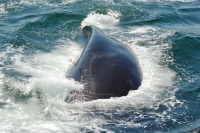
(Photo: Anderson Cabot Center/New England Aquarium and Canadian Whale Institute)

-
Right Whale biopsy (Image 3 of 3).
Learn more
The arrow collects a small piece of skin, about the size of a pencil eraser. This is enough to extract the whale’s DNA from for molecular studies. The DNA can tell us about the whale’s identity, family tree, genetic diversity, effective population size, and reproductive success. Researchers can also use the tissue to study disease in the population and the effects of environmental pollution on whales. The sample is frozen or preserved so that it can be sent on to laboratories. One sample can be divided into several pieces so it can be used for different analyses.
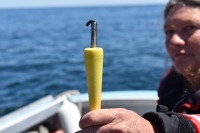
(Photo: Anderson Cabot Center/New England Aquarium)

-
Sampling Zooplankton
We call the animals that drift in the seawater zooplankton. To collect these tiny animals for study we use a plankton net. This is a funnel shaped net with fine mesh. Scientists tow the net slowly behind the boat for a set period – here ten minutes. It collects the zooplankton from the many litres of seawater that pass through it. The ‘cod end’ of the net collects the plankton. It is then transferred into a jar and preserved. Taxonomists can then examine it under a microscope in the laboratory and find out what species are present.
Video Description: Huntsman technician Louise Warner carefully lowers the plankton net into the water from the stern of the ‘Fundy Spray’. She feeds out the rope to let it be towed in the wake of the vessel. Ten minutes later she pulls the net back onboard. Colleague Rebecca Milne steps in to help rinse the net and unscrew the glass jar from the end of the net. We zoom to a close up of plankton in the jar.
-
Rescuing an Entangled Right Whale.
View species
The Campobello Whale Rescue Team attempt to free a right whale that has become tangled in fishing gear. Whale rescue can be dangerous. The team have received training and have experience in the use of specialised equipment to disentangle whales. Apart from marine mammal scientist Moira Brown, all the members of the team are local fishermen.
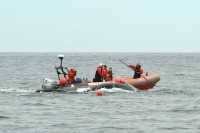
(Photo: Anderson Cabot Centre for Ocean Life/New England Aquarium)

-
North Atlantic Right Whale
View species
In 1980 researchers found 25 North Atlantic right whales in the Bay of Fundy. Before this discovery scientists believed the North Atlantic right whale was nearly extinct. They are still endangered: fewer than 425 individuals remain. Right whales come into Quoddy waters to feed on the dense patches of zooplankton found here.
Video Description: Seen from above, we watch two right whale swim at the surface of a calm sea. Their tails undulate to drive them forward. One blows out producing the v-shapeblow characteristic of the species. The first whale dives and the second follows. The last thing we see is the thin edge of its tail as it dives. This video has no sound.
-
Great Shearwater
View species
Great shearwaters breed on the Tristan da Cuhna island group in the Southern Hemisphere, the most remote inhabited place on earth. They travel over 12,000 kilometres north to Canada’s east coast to feed in their winter (summer here). During their time in the Quoddy region (July to September) they eat krill and herring, building up fat reserves for the long migration south.
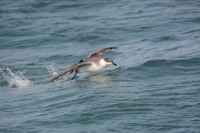
(Photo: Danielle Dion)

-
Humpback Whale
View species
Humpback whales come into the Bay of Fundy in the summer months after a long migration from the West Indies, where many go in the winter to mate and calve.
Video Description: We see a humpback whale from above as it swims at the surface of a calm sea. We can clearly see its white pectoral fins. Then we also glimpse the white fins of two other Humpbacks beneath it in the water. Gradually they surface. As they break the surface they blow out clouds of white vapour. Slowly all three whales start to dive. This video has no sound.
-
Atlantic White-Sided Dolphins
View species
White-sided dolphins are highly social and often travel in large groups. They are fast swimmers, reaching speeds of between 25 and 45 kilometres per hour. They often leap out of the water and may bowride on boats. They can be recognised by their distinctive colouring.
Video Description: We watch from above as a group of six white-sided dolphins swim at the sea surface. They dart and weave, crossing paths, leaping and splashing. Their tails undulate, speeding them through the water. This video has no sound.
-
Breaching Humpback Whale
View species
This humpback whale is leaping out of the water, a behavior known as breaching. Breaching is fairly common in humpbacks, but still fairly unusual to see when out whale watching. Scientists think that the loud sound it makes may be a way of communicating with other humpback whales.
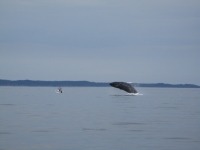
(Photo: Rika Nason)

-
Dead Harbour Porpoise
View species
Passengers on the Quoddy Link came across this porpoise carcass near to the Wolves Islands, on the fringes of the Quoddy Region. Something had bitten the porpoise’s tail off and it was bleeding. A crew member tried to pull the porpoise alongside the boat with a boathook but then a large shark appeared. The crew let the porpoise drift away. Observers could see the shark moving the porpoise around and got glimpses of the shark’s nose and fin. Then the shark pulled the porpoise under. The shark was later identified as a great white from photographs of its fin, nose, and teeth marks.
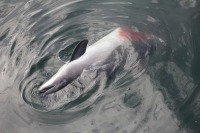
(Photo: Tracey Dean)

-
Feeding Northern Gannets
View species
The northern gannet spends most of its life at sea. This flock is plunge diving for fish. Birds dive into the sea from heights of up to 40 meters. They fold their wings back against their body and enter the water at speeds of over 100 kilometres per hour. The dive takes them down to three to five metres but they can use their wings and feet to swim down to 22 metres. The speed and sharp angle at which they enter the water helps them surprise their prey.
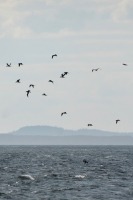
(Photo: Jolinne Surette)

-
Red-necked Phalarope
View species
Red-necked phalaropes congregate in the Quoddy region between July and September. They stop here during their southwards migration from breeding grounds in the Arctic to wintering areas in South America. They stay in the area for 15 to 20 days to feed and build up their fat reserves. Flocks gather where upwellings concentrate their prey, the planktonic copepod Calanus finmarchicus. Numbers of up to 2 million used to pass through but have significantly declined in the past few decades. Scientists are not sure why. It may be the result of climate change affecting populations in their breeding areas.

(Photo: Jolinne Surette)


